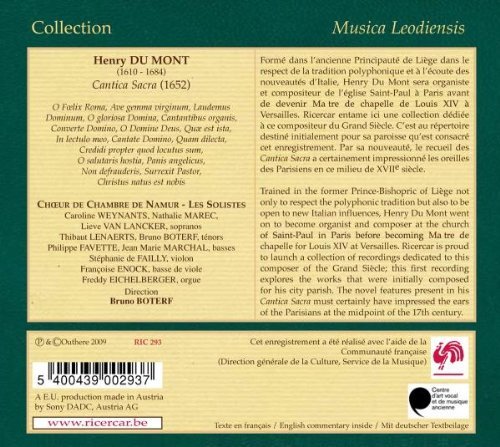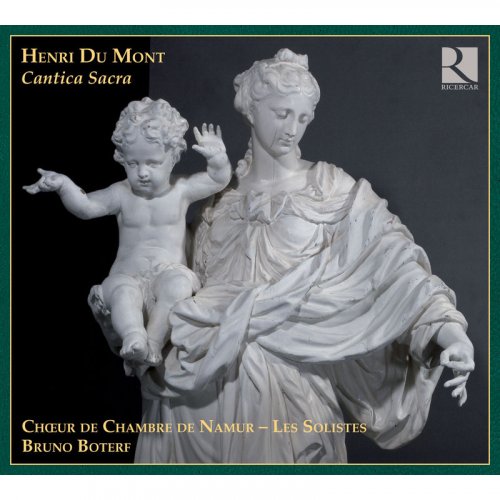
Chœur de Chambre de Namur, Les Solistes, Bruno Boterf - Henry Du Mont: Cantica Sacra (2010)
BAND/ARTIST: Chœur de Chambre de Namur, Les Solistes, Bruno Boterf
- Title: Henry Du Mont: Cantica Sacra
- Year Of Release: 2010
- Label: Ricercar
- Genre: Classical
- Quality: flac lossless +Booklet
- Total Time: 01:12:52
- Total Size: 331 mb
- WebSite: Album Preview
Tracklist
01. O foelix Roma: Hymnus in festo SS. Apostolorum Petri et Pauli
02. Psaume: Cantate Domino à 4 voces
03. Psaume: Quam dilecta à 2 voces
04. Psaume: Credidi propter quod locutus sum à 3 & 4 voces, viol. si placet
05. Psaume: Allemanda à 3 viol.
06. Imploration du pardon: Converte Domine oculos tuos super nos à 3 voces
07. Imploration du pardon: O Domine Deus à 4 voces
08. Imploration du pardon: Pavane à 3 viol.
09. Pour les fêtes de saints: Ave gemma virginum à 4 voces
10. Pour les fêtes de saints: Laudemus Dominum à 3 voces
11. Pour les fêtes de saints: O Gloriosa Domina à 2 voces & 2 viol.
12. Pour les fêtes de saints: Cantantibus organis à 2 voces & 3 viol. si placet
13. Pour les fêtes de saints: Allemanda gravis pro organo
14. Du Cantique des Cantiques: Quae est ista à 2 voces
15. Du Cantique des Cantiques: In lectulo meo, Echo à 2 voces
16. Du Cantique des Cantiques: Pavane pour l'orgue
17. Pour le Saint-Sacrement: O Salutaris hostia à 3 voces
18. Pour le Saint-Sacrement: Panis angelicus, voce sola, vel 4 voces aut instrumenti
19. L'année liturgique: Non defrauderis à 2 & 3 voces (Carême)
20. L'année liturgique: Surrexit pastor bonus à 2 voces & viol. si placet (Pâques)
21. L'année liturgique: Christus natus est à 4 voces & viol. si placet (Noël)

Henry du Mont was a Walloon composer who worked primarily in Paris during the middle Baroque. His 1652 Cantica sacra, published before du Mont achieved his longest post as organist at the Church of St. Paul in Paris, consists of sacred settings from two to four voices that betray the influence of both Palestrina and the madrigal, conceits still belonging to Renaissance practice. However, du Mont also provides a basso continuo, a device still relatively new in 1652 and intractably wedded to the Baroque; he was so proud of his employment of continuo that in the publication du Mont claimed to be the first to publish such music in France, perhaps unaware that he had been preceded by Constantijn Huygens just five years before. However, du Mont's Cantica sacra represents the first ever examples of the distinctively French form known as petites motets, and he would later figure in the development of the grands motets, as well. The 1652 print of Cantica sacra contains 35 pieces, and Ricercar's Henry Du Mont: Cantica sacra features a selection from among them as performed by the outstanding Belgian group Choeur de Chambre de Namur, assisted by a small continuo consisting of violin, bass viol, and organ and the whole being led by tenor Bruno Boterf. On a previous Ricercar release, Choeur de Chambre de Namur had taken on du Mont's Grands motets under the direction of Pierre Pierlot. Within the original edition, du Mont offers alternate realizations for several of the motets and the group follows suit on the hymn O fœlix Roma, with alternating versets heard in a solo organ version, four-voice and two-voice versions, and an Allemande tacked on, serving as an Amen. As all of the pieces in the Cantica sacra are short, they are grouped together under liturgical sub-headings; under the Christmas motet Christus natus est there is a group of 13 pieces that runs only 7:07 all told. There are a few purely instrumental pieces included in the print, and these are also heard; the performance of the Pavane à 3 is perfectly lovely. The singing by Choeur de Chambre de Namur is also wonderful, particularly among the sopranos. The only drawback - and it is significant - is the balance of the organ part, which tends to compete with the voices in the center of the sonic picture, often overpowering them. When the strings are playing, the texture is a bit more comfortable as they provide some measure of competition to the organ, which is mixed a little too loudly. The sign of a good continuo, of course, is its ability to sink into the texture, and this almost sounds like an organ recital with added vocal parts. If one can listen through the organ, then there is some good singing going on here, and the sub-groupings seem a sensible and effective way to transmit such petites motets.
01. O foelix Roma: Hymnus in festo SS. Apostolorum Petri et Pauli
02. Psaume: Cantate Domino à 4 voces
03. Psaume: Quam dilecta à 2 voces
04. Psaume: Credidi propter quod locutus sum à 3 & 4 voces, viol. si placet
05. Psaume: Allemanda à 3 viol.
06. Imploration du pardon: Converte Domine oculos tuos super nos à 3 voces
07. Imploration du pardon: O Domine Deus à 4 voces
08. Imploration du pardon: Pavane à 3 viol.
09. Pour les fêtes de saints: Ave gemma virginum à 4 voces
10. Pour les fêtes de saints: Laudemus Dominum à 3 voces
11. Pour les fêtes de saints: O Gloriosa Domina à 2 voces & 2 viol.
12. Pour les fêtes de saints: Cantantibus organis à 2 voces & 3 viol. si placet
13. Pour les fêtes de saints: Allemanda gravis pro organo
14. Du Cantique des Cantiques: Quae est ista à 2 voces
15. Du Cantique des Cantiques: In lectulo meo, Echo à 2 voces
16. Du Cantique des Cantiques: Pavane pour l'orgue
17. Pour le Saint-Sacrement: O Salutaris hostia à 3 voces
18. Pour le Saint-Sacrement: Panis angelicus, voce sola, vel 4 voces aut instrumenti
19. L'année liturgique: Non defrauderis à 2 & 3 voces (Carême)
20. L'année liturgique: Surrexit pastor bonus à 2 voces & viol. si placet (Pâques)
21. L'année liturgique: Christus natus est à 4 voces & viol. si placet (Noël)

Henry du Mont was a Walloon composer who worked primarily in Paris during the middle Baroque. His 1652 Cantica sacra, published before du Mont achieved his longest post as organist at the Church of St. Paul in Paris, consists of sacred settings from two to four voices that betray the influence of both Palestrina and the madrigal, conceits still belonging to Renaissance practice. However, du Mont also provides a basso continuo, a device still relatively new in 1652 and intractably wedded to the Baroque; he was so proud of his employment of continuo that in the publication du Mont claimed to be the first to publish such music in France, perhaps unaware that he had been preceded by Constantijn Huygens just five years before. However, du Mont's Cantica sacra represents the first ever examples of the distinctively French form known as petites motets, and he would later figure in the development of the grands motets, as well. The 1652 print of Cantica sacra contains 35 pieces, and Ricercar's Henry Du Mont: Cantica sacra features a selection from among them as performed by the outstanding Belgian group Choeur de Chambre de Namur, assisted by a small continuo consisting of violin, bass viol, and organ and the whole being led by tenor Bruno Boterf. On a previous Ricercar release, Choeur de Chambre de Namur had taken on du Mont's Grands motets under the direction of Pierre Pierlot. Within the original edition, du Mont offers alternate realizations for several of the motets and the group follows suit on the hymn O fœlix Roma, with alternating versets heard in a solo organ version, four-voice and two-voice versions, and an Allemande tacked on, serving as an Amen. As all of the pieces in the Cantica sacra are short, they are grouped together under liturgical sub-headings; under the Christmas motet Christus natus est there is a group of 13 pieces that runs only 7:07 all told. There are a few purely instrumental pieces included in the print, and these are also heard; the performance of the Pavane à 3 is perfectly lovely. The singing by Choeur de Chambre de Namur is also wonderful, particularly among the sopranos. The only drawback - and it is significant - is the balance of the organ part, which tends to compete with the voices in the center of the sonic picture, often overpowering them. When the strings are playing, the texture is a bit more comfortable as they provide some measure of competition to the organ, which is mixed a little too loudly. The sign of a good continuo, of course, is its ability to sink into the texture, and this almost sounds like an organ recital with added vocal parts. If one can listen through the organ, then there is some good singing going on here, and the sub-groupings seem a sensible and effective way to transmit such petites motets.
As a ISRA.CLOUD's PREMIUM member you will have the following benefits:
- Unlimited high speed downloads
- Download directly without waiting time
- Unlimited parallel downloads
- Support for download accelerators
- No advertising
- Resume broken downloads


